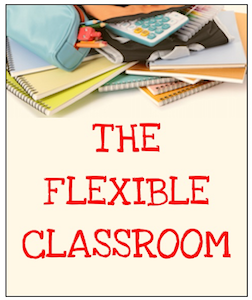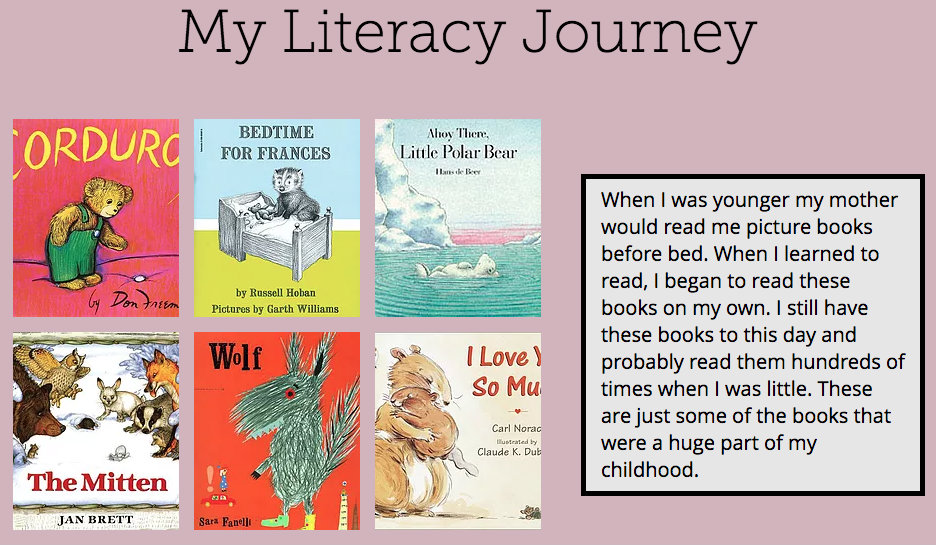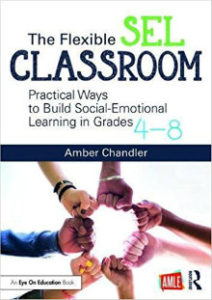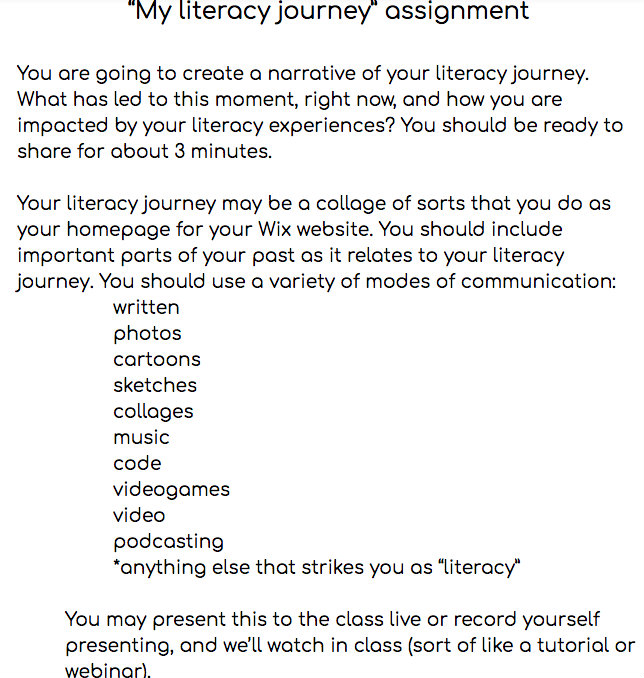Using ‘Literacy Journeys’ to Connect with Students
A MiddleWeb Blog
 For most of my middle school teaching career, I’ve had the privilege to also be an adjunct professor.
For most of my middle school teaching career, I’ve had the privilege to also be an adjunct professor.
When I first made the shift to the middle grades, I missed my high school AP Literature position, and I scratched that itch by teaching “Introduction to Literature” and “Introduction to College Writing” courses.
However, as I grew in the profession, I began teaching classes for teacher preparation programs.
Through the years, I’ve taught literacy classes and teaching methods, and this spring I had the opportunity to teach a class called “Adolescent Literacy in a New Literacy World.” I was as baffled as you probably are when I first read that title, but if you’ve read my column before, you would correctly guess that I just jumped right in.
As it turned out, the course is designed to address the changing role of technology in education due to social media, blogging, podcasting, video production, coding, the use of infographics, and gamification, as well as other developments that are happening literally all the time.
The goal of the course is to help students recognize the evolving nature of literacy, and moreover, help them to realize that literacy is everyone’s responsibility, no matter the subject area. (This video provides an excellent “bird’s eye view” of the impact of literacy on a community.)
Having nearly completed my first semester teaching this course, I want to share an activity that proved to be the most important factor in creating our classroom community, as well as an excellent formative assessment that we returned to time and time again as we talked about literacy. I think you’ll see the connections to our middle grades classrooms.
Learning what students can do
As tempted as I was to hand out a notecard and ask students to write down their favorite books, biggest strengths and weaknesses, as well as other trivia (What kind of ice cream are you?), I instead wanted to see what these students could do, not ask them to tell me about it. I decided that we’d begin with their stories, since I see that as the entrance point into literacy instruction.
I asked my college students to create a webpage (but you could easily do a slideshow or use some other medium) of their “literacy journey.” I gave minimal direction on the assignment because I wanted to use this tool to gauge the collective experiences of my students and see what they’d produce.
It turns out, as a middle school ELA teacher, that this is my new starting point for the school year (in the past, I’ve started with “I AM” poems, One Word, and many other ways to get to know students).
The reason this literacy journey activity is so powerful is that it is reflective and helps students learn about each other, setting the stage for a caring classroom, while also providing me with some great data points about my students.
A semester-long journey
By finding out the “real story” of their literacy, I was able to assign students to activities based on their interest. Take a look at these examples: Anna Shatzel, Brett Davis, and Nicole Newton.
I was able to learn about Anna’s interest in videography, Brett’s gaming and martial arts background, and Nicole’s interest in foreign language. As we addressed topics in the class, I was able to draw upon their experiences and to help them recognize that these were legitimately a part of “new literacy” and were the exact topics they’d need to think about as they prepared to become teachers.

From Anna’s website. Click to enlarge.
The biggest takeaway from the activity was one that I had not expected. As a professor new to this course, I had struggled to articulate in my syllabus, and even my own thinking, exactly why we needed to appreciate these “new literacies.”
However, as students told their own stories, it became evident that as teachers we need to recognize who is in the room and ways to connect with them. As we’ve traveled this semester together, it has been a touchstone experience that they return to when they think about ways to reach their students.
As students told their own stories, it became evident that as teachers we need to recognize who is in the room and ways to connect with them.” – Amber Chandler
I’m looking forward to doing this assignment in the fall with my new 8th graders because I think it will give me more information than the activities I’ve done before. And then, as our year draws to a close, I love the idea of coming full circle and having students reflect back on their 8th grade year and have them update the story of their journey with experiences we’ve shared together.
If you’re curious about the assignment, I suggest you give it a try first by tracing your own literacy journey. I think your product can be a great way to introduce yourself to your kiddos and model the activity, too.
Here’s mine! If anyone gives this a try, please let me know, as I’d love to showcase your journey on my website as well.
_____________________________________________________________________
 Amber Chandler’s latest book is The Flexible SEL Classroom: Practical Ways to Build Social-Emotional Learning in Grades 4-8. Sample one of her recent SEL posts here at MiddleWeb. Her first book, The Flexible ELA Classroom, was co-published by Routledge/MiddleWeb.
Amber Chandler’s latest book is The Flexible SEL Classroom: Practical Ways to Build Social-Emotional Learning in Grades 4-8. Sample one of her recent SEL posts here at MiddleWeb. Her first book, The Flexible ELA Classroom, was co-published by Routledge/MiddleWeb.


































